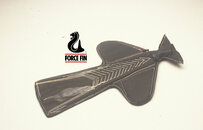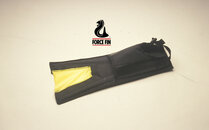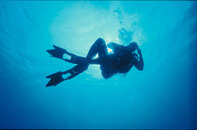No, it's not. It's a discussion on the fluid dynamics which causes diver propulsion, and some of the misconceptions by divers about that. Some of those misconceptions apply to the Force Fin. I started using mine again last summer, and was surprised at how well they performed in the current. Bob Evans talked just a bit about the Force Fin's performance in the water, but what I found is that the profile of the fin split the current's force, and did not affect the fin (I've had other fins pull off my feet in a strong current, including one of my scoop fins).
In
Swimming into the 21st Century, Cecil M. Colwin discusses on page 61 "How a Starting Vortex Creates Circulation in the Form of a Bound Vortex." He discusses this in relationship to how these vortex's are formed:
This is also true of fins, and especially the Force Fin. My scoop fins do the same too. But the Force Fin, with its very high degree of snap back, produces very good shed vortex's. This is propulsion! You can see these vortex's in the bubble formation from surface swimming. You can also see where the vortex goes (down, or backward). I have some video of this, but will need to do some work to get them onto YouTube and visible here (may take some time--I'm working on other things too).
Now, about my scoop fins, the Murdock patent covered it:
View attachment 512259
But if you wish to make some, feel free. It will take time and effort to do so, but it would be interesting to do it. Here's what my third try at it looked like in 1970:
View attachment 512260
You want the flexible membrane to be tight at the toes, but make a semi-circle at the tip of the fins. Any flexible waterproof fabric (neoprene-impregnated nylon or something similar) will work.
Or, you can buy some Force Fins and save yourself a lot of labor. Below you can see a screen shot of the shed vortex's of the Force Fin at the end of one whip kick stroke. Note that the bubbles are mostly behind me.
View attachment 512261Force Fin Sted Vortex's by
John Ratliff, on Flickr
Here you can see the bound vortex coming off the edge of the Force Fin using a flutter kick:
View attachment 512265Force Fin Bound Vortex--flutter kick by
John Ratliff, on Flickr
SeaRat










